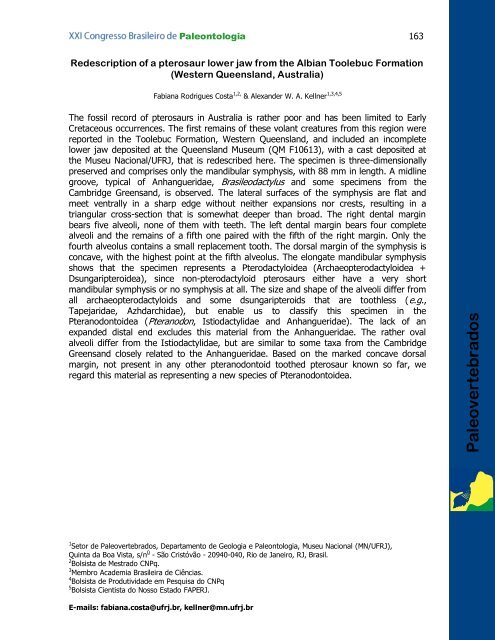Livro de Resumos - Dinossauros do Maranhão
Livro de Resumos - Dinossauros do Maranhão
Livro de Resumos - Dinossauros do Maranhão
Create successful ePaper yourself
Turn your PDF publications into a flip-book with our unique Google optimized e-Paper software.
Paleontologia 163<br />
Re<strong>de</strong>scription of a pterosaur lower jaw from the Albian Toolebuc Formation<br />
(Western Queensland, Australia)<br />
1 Setor <strong>de</strong> Paleovertebra<strong>do</strong>s, Departamento <strong>de</strong> Geologia e Paleontologia, Museu Nacional (MN/UFRJ),<br />
Quinta da Boa Vista, s/n 0 - São Cristóvão - 20940-040, Rio <strong>de</strong> Janeiro, RJ, Brasil.<br />
2 Bolsista <strong>de</strong> Mestra<strong>do</strong> CNPq.<br />
3 Membro Aca<strong>de</strong>mia Brasileira <strong>de</strong> Ciências.<br />
4 Bolsista <strong>de</strong> Produtivida<strong>de</strong> em Pesquisa <strong>do</strong> CNPq<br />
5 Bolsista Cientista <strong>do</strong> Nosso Esta<strong>do</strong> FAPERJ.<br />
Fabiana Rodrigues Costa 1,2, & Alexan<strong>de</strong>r W. A. Kellner 1,3,4,5<br />
The fossil record of pterosaurs in Australia is rather poor and has been limited to Early<br />
Cretaceous occurrences. The first remains of these volant creatures from this region were<br />
reported in the Toolebuc Formation, Western Queensland, and inclu<strong>de</strong>d an incomplete<br />
lower jaw <strong>de</strong>posited at the Queensland Museum (QM F10613), with a cast <strong>de</strong>posited at<br />
the Museu Nacional/UFRJ, that is re<strong>de</strong>scribed here. The specimen is three-dimensionally<br />
preserved and comprises only the mandibular symphysis, with 88 mm in length. A midline<br />
groove, typical of Anhangueridae, Brasileodactylus and some specimens from the<br />
Cambridge Greensand, is observed. The lateral surfaces of the symphysis are flat and<br />
meet ventrally in a sharp edge without neither expansions nor crests, resulting in a<br />
triangular cross-section that is somewhat <strong>de</strong>eper than broad. The right <strong>de</strong>ntal margin<br />
bears five alveoli, none of them with teeth. The left <strong>de</strong>ntal margin bears four complete<br />
alveoli and the remains of a fifth one paired with the fifth of the right margin. Only the<br />
fourth alveolus contains a small replacement tooth. The <strong>do</strong>rsal margin of the symphysis is<br />
concave, with the highest point at the fifth alveolus. The elongate mandibular symphysis<br />
shows that the specimen represents a Pterodactyloi<strong>de</strong>a (Archaeopterodactyloi<strong>de</strong>a +<br />
Dsungaripteroi<strong>de</strong>a), since non-pterodactyloid pterosaurs either have a very short<br />
mandibular symphysis or no symphysis at all. The size and shape of the alveoli differ from<br />
all archaeopterodactyloids and some dsungaripteroids that are toothless (e.g.,<br />
Tapejaridae, Azhdarchidae), but enable us to classify this specimen in the<br />
Pterano<strong>do</strong>ntoi<strong>de</strong>a (Pterano<strong>do</strong>n, Istiodactylidae and Anhangueridae). The lack of an<br />
expan<strong>de</strong>d distal end exclu<strong>de</strong>s this material from the Anhangueridae. The rather oval<br />
alveoli differ from the Istiodactylidae, but are similar to some taxa from the Cambridge<br />
Greensand closely related to the Anhangueridae. Based on the marked concave <strong>do</strong>rsal<br />
margin, not present in any other pterano<strong>do</strong>ntoid toothed pterosaur known so far, we<br />
regard this material as representing a new species of Pterano<strong>do</strong>ntoi<strong>de</strong>a.<br />
E-mails: fabiana.costa@ufrj.br, kellner@mn.ufrj.br<br />
Paleovertebra<strong>do</strong>s


